
The Virginian Railway Passenger Station, also known as the Virginian Station is a former rail station listed on the National Register of Historic Places in the South Jefferson neighborhood of the independent city of Roanoke, Virginia, U.S.A. Located at the intersection of Jefferson Street SE and Williamson Road, the Virginian Station served as a passenger station for the Virginian Railway between 1910 and 1956. The station was the only station constructed with brick along the entire length of the Virginian's 608 miles (978 km) network. It was severely damaged by fire on January 29, 2001.
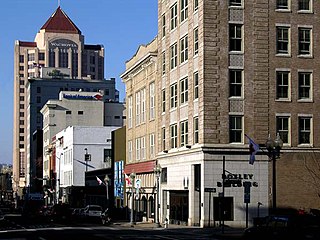
The Roanoke Downtown Historic District is a national historic district located in the Downtown Roanoke area of Roanoke, Virginia. It encompasses 122 contributing buildings. It includes a variety of commercial, institutional, social, and governmental buildings and structures from the late 19th century to the mid-20th century. Notable buildings include the Roanoke City Public Library, the YMCA Central Branch Building, First Christian Church (1925), the Central Church of the Brethren (1924), Tomnes Cawley Funeral Home (1928), Thomas B. Mason Building (1961), Peerless Candy Co., City Hall / Municipal Building (1915), Roanoke Times Building (1892), Anchor Building / Shenandoah Building (1910), Greene Memorial Methodist Church (1890), and United States Post Office and Courthouse (1930). Located in the district are the separately listed Patrick Henry Hotel, the Boxley Building, the Campbell Avenue Complex Historic District, Colonial National Bank, and First National Bank.

Roanoke City Market Historic District, also known as City Market District, is a national historic district located in the Downtown Roanoke area of Roanoke, Virginia.

The Lower Basin Historic District is a national historic district located in Lynchburg, Virginia. The district defines a commercial and industrial warehouse area located between the downtown commercial area to the south and the James River waterfront to the north. The district contains a variety of mostly late 19th- and early 20th-century, multi-story, brick warehouses and factories, two-to-three-story brick commercial buildings, and a number of structures associated with the James River and Kanawha Canal and the Norfolk and Western and Chesapeake and Ohio Railways. The district is named for a wide basin of the canal that once extended between Ninth Street and Horseford Road, and contains 60 contributing buildings, two contributing structures, and one contributing object-a monument commemorating the site of 18th-century Lynch's Ferry.
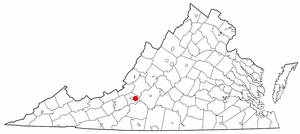
This is a list of the National Register of Historic Places listings in Roanoke, Virginia.

Salem Veteran Affairs Medical Center (VAMC) is one of the largest VA hospitals located at 1970 Roanoke Blvd. Salem, Virginia 24153. Since 1934 VAMC in Salem has been improving the health of the men and women who have so proudly served the United States Navy, United States Army, United States Air Force, United States Coast Guard and United States Marines. Health care services have been provided to more than 112,500 veterans living in a 26-county area of southwestern Virginia. Salem VAMC provided community-based outpatient clinics. In addition to the main facility in Salem, there are affiliated services in three community-based outpatient clinics. These clinics are located in Danville, Hillsville, Lynchburg, and Tazewell, Virginia, Wythville.11

Markham Historic District is a national historic district located at Markham, Fauquier County, Virginia. It encompasses 44 contributing buildings and 4 contributing sites in the rural villages of Farrowsville and Markham. The majority of resources in the district were constructed in the mid- and late 19th century and include multiple dwellings, a hotel, as well as commercial buildings, and a train station. The district also contains early-20th-century dwellings. Notable buildings include Mountain View, Wolfs Crag, Rosebank, Markham School (1918), the 1819 stone Upper Goose Creek Church, and the former Markham Freight Station.
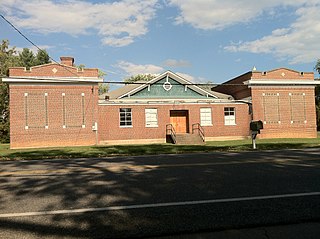
Starkey School is a historic school building located at Starkey, Roanoke County, Virginia. It was built about 1915, and is thought to incorporate an earlier one-room school built about 1894. It is a brick school building flanked by wings built in 1928, and measuring 24 feet by 33 feet. In December 1962, the school was closed and was purchased by Roanoke County. The school is now privately owned.
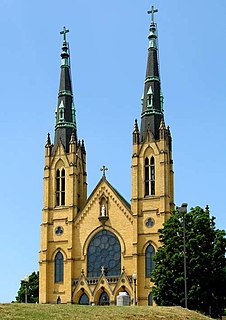
St. Andrew's Catholic Church is a historic Roman Catholic church and rectory in Roanoke, Virginia, United States. It was built in 1900-1902, and is a buff brick church on a stone foundation in the High Victorian Gothic style. It has a cruciform plan and features two tall Gothic towers which flank the main entrance and are square in plan. On each tower are two small lancet windows, two large pointed-arch stained-glass tracery windows, and sets of double pointed-arch openings at the belfry. Also on the property is a rectory built in 1887. The church replaced an earlier small brick church built in 1883.

Campbell Avenue Complex, also known as the Trinkle Buildings, is a historic commercial block and national historic district located at Roanoke, Virginia. It encompasses five contributing buildings constructed between 1892 and 1909. The contiguous three-story buildings are constructed of brick over stone foundations. The buildings have a horizontal arrangement of windows above first-floor storefronts and include buildings representative of the Beaux Arts and Tudor Revival styles.

Southwest Historic District is a national historic district located at Roanoke, Virginia. It encompasses 1,547 contributing buildings constructed between 1882 and 1930 in the Roanoke neighborhoods of Old Southwest, Mountain View, and Hurt Park. It is a primarily residential district with houses in a variety of popular late-19th and early-20th century architectural styles. The district also includes a small number of commercial structures, churches, and two schools.

Norfolk and Western Railway Company Historic District is a national historic district located at Roanoke, Virginia. It encompasses three contributing buildings constructed by the Norfolk and Western Railway. They are the Neoclassical Revival style General Office Building-South ; the Art Deco period General Office Building-North (1931); and the Moderne style Passenger Station. The Passenger Station was renovated by architect Raymond Loewy in 1949. The Passenger Station is occupied by the O. Winston Link Museum.

Henry Street Historic District is a national historic district located at Roanoke, Virginia. It encompasses four contributing buildings constructed between 1917 and 1951. They were developed as the central business and entertainment district for the African-American neighborhood of Gainsboro in Northwest Roanoke. They are the Hotel Dumas (1917), The Strand Theatre (1923), Dr. Lylburn Downing office, and a commercial building (1951).

Gainsboro Historic District is a national historic district located of Roanoke, Virginia. It encompasses 202 contributing buildings and 1 contributing structure in the African-American neighborhood of Gainsboro in Northwest Roanoke. They include single- and multiple-family dwellings, three churches; one parish hall, the Gainsboro Library, a theater, a hotel, two medical office buildings, six commercial buildings, one industry and one bridge. The buildings were primarily built between 1890 and 1925. Located in the district are the separately listed Gainsboro Branch of the Roanoke City Public Library and Henry Street Historic District.

Salem Avenue–Roanoke Automotive Commercial Historic District is a national historic district located of Roanoke, Virginia. It encompasses 59 contributing buildings in the southwestern part of the City of Roanoke. The district includes a variety of buildings having automotive, warehouse, light industrial and residential uses. Most of the buildings are small-scale, one or two-story brick or concrete block buildings, with the majority built between about 1920 and 1954. Notable buildings include the former Enfield Buick Dealership, Lindsay-Robinson & Co. Building (1918), Fulton Motor Company Auto Sales & Service (1928), Lacy Edgerton Motor Company, Roanoke Motor Car Company, and Fire Department No. 3 (1909).
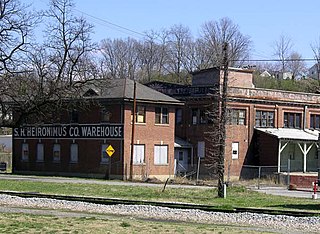
Virginia Can Company-S.H. Heironimus Warehouse is a historic factory and warehouse complex located at Roanoke, Virginia. The "U"-shaped complex was built in 1912, and consists of an office and two factory buildings. All three of the buildings are two stories in height and are constructed of brick on a raised foundation of poured concrete. A second-story pedestrian bridge connects the two factory buildings and a brick hyphen connects the office building to the north factory building. The complex was built for the Virginia Can Company, the first and largest manufacturer of tin cans in Roanoke, Virginia. After 1951, it housed a clothing factory and then the Heironimus department store warehouse.
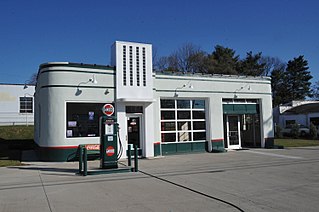
Carlin's Amoco Station is a historic Amoco service station located at Roanoke, Virginia. It was built about 1947, and remodeled about 1953 in the Streamline Moderne style. The one-story gas station is constructed of concrete block covered with stucco and sits on a concrete slab foundation. Also on the property is an associated repair shop constructed about 1947.

Old Roanoke County Courthouse is a historic courthouse building located at Salem, Virginia. It was built in 1909-1910 and is a three-story, Classical Revival-style, yellow brick building. The front facade features a three-story, tetra-style Ionic order portico. The courthouse has a hipped roof topped by a cupola, which is topped by an eagle. A rear addition was built in 1948–1949. Also on the property is the contributing 1910 Civil War Memorial, that consists of a granite shaft topped by the figure of a Confederate soldier. The building housed Roanoke County, Virginia county offices until they moved to a new building in 1985.

Wharf Area Historic District is a national historic district located at Staunton, Virginia. The district encompasses 22 contributing buildings and 4 contributing structures. It is a warehouse and commercial district characterized by rows of late-19th century and early-20th century storefronts and an elongated plaza framed by small warehouses. The buildings are characteristically two- and three-story, brick structures in a variety of popular architectural styles including Greek Revival, Federal, and Queen Anne. Notable buildings and structures include the Railroad Water Tower, American Hotel, John Burns Building (1874), Erskine Building (1904), and Chesapeake and Ohio Railroad Station (1902).

Fincastle Historic District is a national historic district located at Fincastle, Botetourt County, Virginia. It encompasses nine contributing buildings in the central business district of Fincastle. The district resources portray an excellent example of a typical small 19th century town. The buildings include examples of Late Victorian, Greek Revival, and Gothic Revival styles. Notable buildings include the Botetourt County Courthouse and jail, Methodist Church, Presbyterian Church, St. Mark's Episcopal Church (1837), the Peck House, Selander House, Ammen House, and Kyle House (1832).























